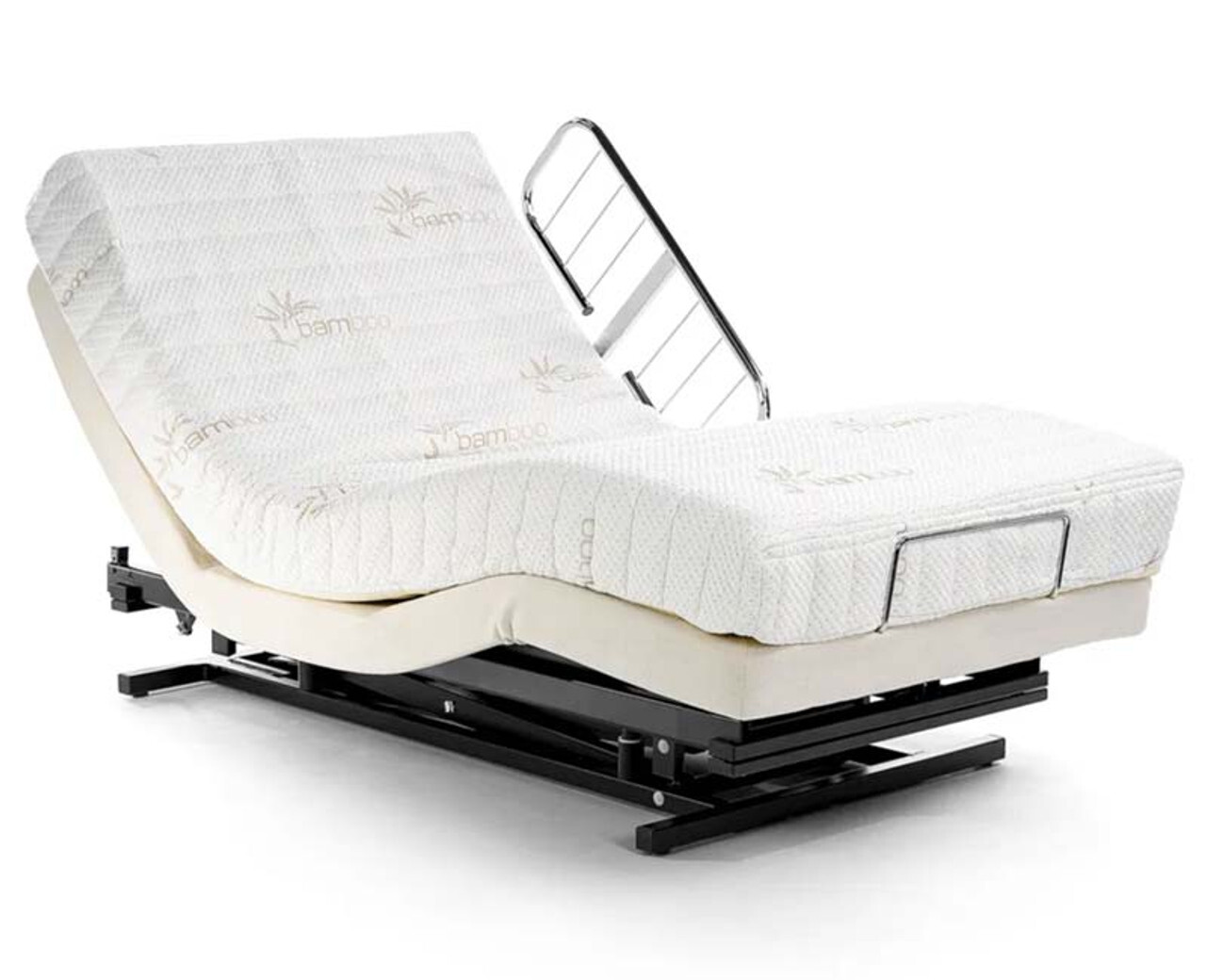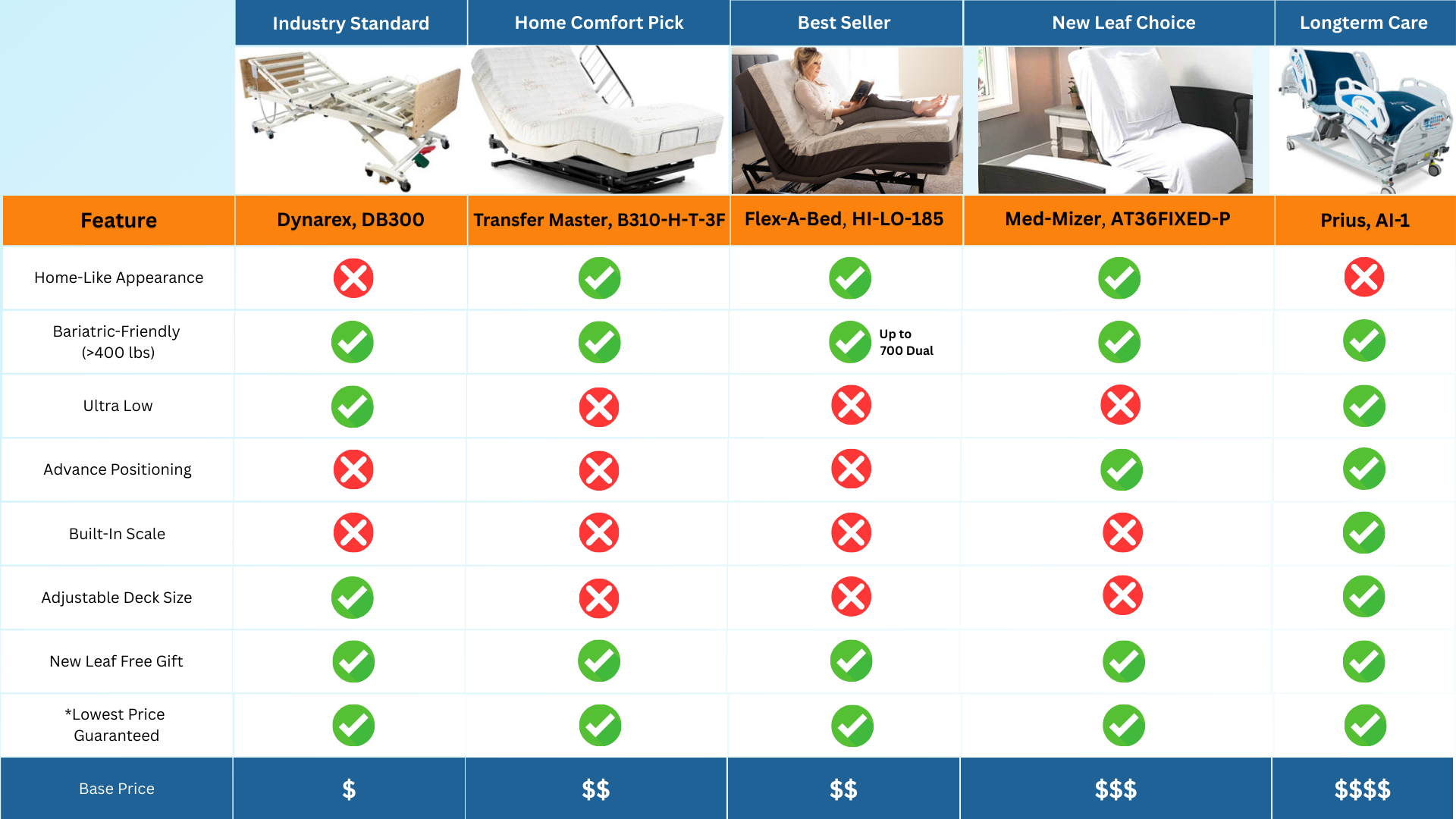FREE SHIPPING ON ORDERS OVER $75
Hospital Bed Accessories and Attachments

Equipping a hospital bed with the right accessories can significantly improve the comfort, safety, and overall functionality for those receiving care at home. Whether it’s an overbed table for convenient access, side rails for added security, or an IV pole for medical needs, each accessory brings essential support to daily life. These attachments help create a tailored, comfortable, and efficient care environment, easing both the patient's experience and caregiver responsibilities.
Adding suitable hospital bed accessories can transform a basic bed  into a versatile and functional care space. Let's explore the key types of hospital bed attachments, how they enhance daily life, and which accessories are worth considering.
into a versatile and functional care space. Let's explore the key types of hospital bed attachments, how they enhance daily life, and which accessories are worth considering.
Overview of Essential Accessories
 Hospital bed accessories are designed to enhance both safety and convenience, making it easier for patients to perform everyday activities while maintaining a sense of independence. Accessories such as side rails, overbed tables, and bedpans offer practical support, helping patients manage activities like eating, moving, and accessing essentials without leaving the bed.
Hospital bed accessories are designed to enhance both safety and convenience, making it easier for patients to perform everyday activities while maintaining a sense of independence. Accessories such as side rails, overbed tables, and bedpans offer practical support, helping patients manage activities like eating, moving, and accessing essentials without leaving the bed.
These attachments also reduce caregiver strain by providing convenient features that improve access and reduce the need for constant physical assistance. For example, side rails can prevent falls, while overbed tables give patients easy access to personal items, reducing the frequency of caregiver intervention.
convenient features that improve access and reduce the need for constant physical assistance. For example, side rails can prevent falls, while overbed tables give patients easy access to personal items, reducing the frequency of caregiver intervention.
Types of Accessories
Side Rails for Safety and Stability
Side rails are one of the most essential hospital bed accessories, providing added security and preventing falls. They offer physical support for patients getting in and out of bed and act as a boundary that can reduce the risk of rolling out of bed during sleep. Side rails are especially beneficial for individuals who may experience limited mobility or confusion, as they help to maintain a safe sleeping environment.
Some side rails come with built-in features, such as padding for added comfort or adjustable heights to meet specific needs. For those needing occasional support, half-rails may be sufficient, while full rails provide more comprehensive coverage and security.
Overbed Tables for Accessibility
Overbed tables are invaluable for patients who spend extended periods in bed. These tables are adjustable and can be positioned over the bed, allowing patients to eat, read, or use electronic devices with ease. They provide a stable surface within reach, enabling patients to maintain their independence by accessing meals, drinks, and personal items without help.
Many overbed tables are designed with wheels, making them easy to move as needed. Some models offer additional features like storage compartments or tilt options, providing flexibility based on patient activities and preferences.
IV Poles and Attachments for Medical Needs
IV poles are crucial for patients who require regular intravenous treatments or hydration, as they keep IV bags and lines securely in place. These poles can either be built into the bed frame or attached as a separate accessory, depending on the bed model. IV poles allow patients to receive continuous medical care without needing to be transported, which is particularly beneficial for those with chronic conditions requiring frequent treatment.
Some IV poles are adjustable and come with hooks for multiple bags, accommodating complex care needs. For patients on long-term IV therapy or medication, having a reliable IV pole integrated with the hospital bed can greatly enhance care efficiency.
Lifts and Transfer Aids
Lifts and transfer aids help patients get in and out of bed safely and with minimal assistance, reducing the risk of injury for both the patient and caregiver. These aids range from basic lift supports to motorized transfer systems, making them suitable for various levels of mobility. For patients with significant physical limitations, lifts provide essential support and allow caregivers to perform transfers without strain.
Transfer aids are particularly helpful for individuals with mobility issues who require assistance standing or moving from the bed to a wheelchair. With these aids, both safety and independence are improved, fostering a more comfortable and secure care environment.
Customizing Beds with Accessories
Creating a Personalized Care Setup
 Customizing a hospital bed with the right combination of accessories allows caregivers to create a setup that suits the patient’s specific needs. For example, a setup for someone with limited mobility may include side rails, a lift, and an overbed table, whereas a patient needing long-term IV therapy may prioritize an IV pole. Tailoring the accessories to the patient’s needs can greatly enhance comfort, safety, and ease of care.
Customizing a hospital bed with the right combination of accessories allows caregivers to create a setup that suits the patient’s specific needs. For example, a setup for someone with limited mobility may include side rails, a lift, and an overbed table, whereas a patient needing long-term IV therapy may prioritize an IV pole. Tailoring the accessories to the patient’s needs can greatly enhance comfort, safety, and ease of care.
By carefully selecting accessories that align with both patient preferences and health requirements, caregivers can create an environment that promotes independence, reduces stress, and ensures that essential items and support systems are always within reach.
Enhancing Safety and Independence
Accessories such as side rails and overbed tables promote independence by allowing patients to access necessary items, such as food, personal belongings, and medication, without relying heavily on caregivers. This independence not only improves the patient’s quality of life but also reduces the demand on caregivers, allowing them to focus on other aspects of care.
 Additionally, accessories like transfer aids and lifts reduce the risk of falls and injuries, promoting safety while allowing patients to engage in daily activities more freely. A well-accessorized hospital bed setup provides a secure and empowering space, giving both patients and caregivers peace of mind.
Additionally, accessories like transfer aids and lifts reduce the risk of falls and injuries, promoting safety while allowing patients to engage in daily activities more freely. A well-accessorized hospital bed setup provides a secure and empowering space, giving both patients and caregivers peace of mind.
Top-Rated Attachments
When selecting hospital bed accessories, choosing top-rated and high-quality attachments ensures durability and reliability. Here are some highly recommended options:
- Adjustable Side Rails: Look for side rails with padding options and adjustable heights to suit the patient’s safety needs.
- Overbed Tables with Storage: Tables with storage compartments offer added convenience, allowing patients to keep essentials close by without clutter.
- Multi-Hook IV Poles: Poles with multiple hooks allow for greater flexibility in managing IV bags, which is essential for complex medical needs.
- Comfortable Bed Pans: Choose bed pans made from durable, easy-to-clean materials, and consider disposable options for short-term care needs.
- Motorized Lifts: Motorized lifts provide smooth transitions and reduce physical strain, ideal for patients with limited mobility.

Final Thoughts
Hospital bed accessories play a crucial role in creating a supportive, comfortable, and safe environment for patients receiving care at home. From overbed tables that enhance accessibility to side rails that provide safety, each accessory contributes to a more functional and adaptable space. By selecting accessories that align with specific health needs, caregivers can optimize the care experience, reducing strain on themselves while enhancing patient comfort and independence.
In the end, the right accessories transform a hospital bed from a simple sleeping arrangement into a personalized care station, empowering patients and caregivers alike. With the appropriate attachments, a hospital bed setup can provide the essential support needed to navigate daily routines comfortably and safely, bringing peace of mind and improved quality of life to those who need it most.
